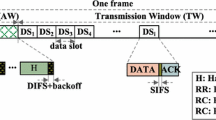Abstract
A Distributed Medium Access Control (D-MAC) protocol based on UWB for high-rate Wireless Personal Area Networks is specified by the WiMedia Alliance. D-MAC protocol is suitable for ubiquitous connection in home networks, military/medical applications due to its inexpensive cost, low power consumption, high data rate, and distributed approach. In contrast to IEEE 802.15.3, D-MAC makes all devices have the same functionality. And its networks are self-organized and provide devices with functions such as access to the medium, channel allocation to devices, data transmission, quality of service and synchronization in a distributed manner. D-MAC fundamentally removes the problems of the centralized MAC approach revealed at IEEE 802.15.3 MAC by adopting a distributed architecture. However, the current D-MAC can’t prevent QoS degradations, occurred by mobile nodes with low data rate due to bad channel status, which cause critical problems in QoS provisioning to isochronous streams and mobile applications. Therefore, we propose a distributed cooperative MAC protocol for multi-hop WiMedia networks using virtual MIMO links. Based on instantaneous Channel State Information among WiMedia devices, our proposed protocol can intelligently select the transmission path with higher data rate to provide advanced QoS with minimum delay for real-time multimedia streaming services.
Similar content being viewed by others
Abbreviations
- UWB:
-
Ultra Wide-Band
- D-MAC:
-
Distributed Medium Access Control
- DRP:
-
Distributed Reservation Protocol
- WPAN:
-
Wireless Personal Area Network
References
IEEE Standard for Information Technology. (2003). Telecommunications and information exchange between systems—Local and metropolitan area networks—Specific requirements Part 15.3: Wireless Medium Access Control (MAC) and Physical Layer (PHY) Specifications for High Rate Wireless Personal Area Networks (WPANs), IEEE 802.15.3.
Xing, G., & Huang, Q. (2006). WiMedia MAC Release Spec. 1.01. Distributed Medium Access Control (MAC) for Wireless Networks, http://www.wimedia.org/en/index/asp .
Siam, M., Krunz, M., & Younis, O. (2009). Energy-efficient clustering/routing for cooperative MIMO operation in sensor networks. In Proceedings of IEEE INFOCOM’09, pp. 621–629.
Kamerman A., Monteban L. (1997) WaveLAN II: A high-performance wireless LAN for the unlicensed band. Bell Labs Technology Journal 2: 118–133
Holland, G., Vaidya, N., & Bahl, P. (2001). A rate-adaptive MAC protocol for multihop wireless networks. In Proceedings of MOBICOM’01, pp. 236–251.
Liu P., Tao Z., Narayanan S., Korakis T., Panwar S. S. (2007) CoopMAC: A cooperative MAC for wireless LANs. IEEE Journal on Selected Areas in Communications 25(2): 340–354
Zhu , Cao G. (2006) rDCF: A relay-enabled medium access control protocol for wireless ad hoc networks. IEEE Transactions of Mobile Computation, 5(9): 1201–1214
Kramer, G., Maric, I., & Yates, R. D. (2006). Cooperative Communications. Hanover, MA.
Laneman J. N., Tse D. N. C., Wornell G. W. (2004) Cooperative diversity in wireless networks: Efficient protocols and outage behavior. IEEE Transactions of Information Theory 50(12): 3062–3080
Laneman J. N., Wornell G. W. (2003) Distributed space-time coded protocols for exploiting cooperative diversity in wireless networks. IEEE Transactions of Information Theory 49(10): 2415–2425
Sendonaris A., Erkip E., Aazhang B. (2003) User cooperation diversity part I and part II. IEEE Transactions of Communications 51(11): 1927–1948
Vajapeyam M., Mitra U. (2010) Performance analysis of distributed space-time coded protocols for wireless multi-hop communications. IEEE Transactions of Wireless Communication 9(1): 122–133
Halunga S. V., Vizireanu D. N. (2010) Performance evaluation for conventional and MMSE multiuser detection algorithms in imperfect reception conditions. Digital Signal Processing, 20(1): 166–178
Halunga S. V., Vizireanu D. N., Fratu O. (2009) Imperfect cross-correlation and amplitude balance effects on conventional multiuser decoder with turbo encoding. Digital Signal Processing 20(1): 191–200
Jakllari, G., Krishnamurthy, S. V., Faloutsos, M., Krishnamurthy, P. V., & Ercetin, O. (2006). A framework for distributed spatio-temporal communications in mobile ad hoc networks. In Proceedings of IEEE INFOCOM’06, pp. 1–13.
Azgin, A., Altunbasak, Y., & AlRegib, G. (2005). Cooperative MAC and Routing Protocols for Wireless Ad Hoc Networks. In Proceedings of IEEE GLOBECOM ’05 (Vol. 5, pp. 2854–2859).
Liu, F., Korakis, T., Tao, Z., & Panwar, S. (2008). A MAC-PHY cross-layer protocol for wireless as hoc networks. In Proceedings of IEEE WCNC’08, pp. 1792–1797.
Guo T., Carrasco R. (2009) CRBAR: Cooperative relay-based auto rate MAC for multirate wireless networks. IEEE Transactions of Wireless Communication 8(12): 5938–5947
Shan, H., Wang, P., Zhuang, W., & Wang, Z. (2008). Cross-layer cooperative triple busy tone multiple access for wireless networks. In Proceedings of IEEE GLOBECOM’08, pp. 1–5.
Zhao B., Valenti M. C. (2005) Practical Relay Networks: A Generalization of Hybrid-ARQ. IEEE Journal on Selected Areas in Communications 23(1): 7–18
Dianati M. et al (2006) A node cooperative ARQ scheme for wireless ad hoc networks. IEEE Transactions of Vehicular Technology 55(3): 1032–1044
Li, T., Ni, Q., Turletti, T., & Xiao, Y. (2005). Performance analysis of the IEEE 802.le Block ACK scheme in a noisy channel. In Proceedings of IEEE BroadNet 2005 (Vol. 1, pp. 511–517).
Faruqui, R., & Ghani, S. (2008). A Simulation Study of Block Acknowledgements and TXOPs under Varying Channel Conditions. In Proceedings of IEEE INMIC 2008 (Vol. 1, pp. 286–289).
Lee, H., Tinnirello, I., Yu, J., & Choi, S. (2007). Throughput and delay analysis of IEEE 802.11e Block ACK with channel errors. In Proceedings of COMSWARE 2007.
Zhou T., Sharif H., Hempel M., Mahasukhon P., Wei W., Tao M. (2011) A novel adaptive distributed cooperative relaying MAC protocol for vehicular networks. IEEE Journal of Selected Areas Communication 29(1): 72–82
He X., Li F. Y. (2010) Cooperative MAC design in multi-hop wireless networks: Part I: When source and destination are within the transmission range of each other. Wireless Personal Communications 57(3): 339–350
Ban T.-W., Jung B.-C. (2011) Cooperative diversity in a spectrum sharing environment. Journal of Information and Communication Convergence Engineering 9(5): 515–522
Author information
Authors and Affiliations
Corresponding author
Rights and permissions
About this article
Cite this article
Kim, JW., Hur, K. & Kwon, J. A Distributed Cooperative MAC Protocol for QoS Improvement and Mobility Support in WiMedia Networks. Wireless Pers Commun 69, 1143–1164 (2013). https://doi.org/10.1007/s11277-012-0625-3
Published:
Issue Date:
DOI: https://doi.org/10.1007/s11277-012-0625-3




